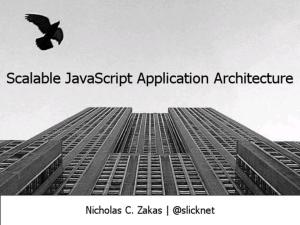- 本月热门
-
 JavaScript Best Practices(JS最佳实践) by Christian Heilmann@Yahoo(2009)
JavaScript Best Practices(JS最佳实践) by Christian Heilmann@Yahoo(2009) -
 AngularJS the performance parts(AngularJS性能:过去现在和未来) by toddmotto
AngularJS the performance parts(AngularJS性能:过去现在和未来) by toddmotto -
 NoSQL and Postgres简介 by 萧少聪@EDB
NoSQL and Postgres简介 by 萧少聪@EDB -
 高效的ES6 (ECMAScript 6入门教程) by teppeis(日)
高效的ES6 (ECMAScript 6入门教程) by teppeis(日) -
 微信背后的产品观-不要听从“产品经理”的需求 by 张小龙@腾讯
微信背后的产品观-不要听从“产品经理”的需求 by 张小龙@腾讯 -
 CSS Checker 检查你的CSS语法错误 by Michael[tm] Smith
CSS Checker 检查你的CSS语法错误 by Michael[tm] Smith -
 Scalable JavaScript Application Architecture(可扩展的JavaScript应用架构) by Nicholas C. Zakas@slicknet
Scalable JavaScript Application Architecture(可扩展的JavaScript应用架构) by Nicholas C. Zakas@slicknet -
 Why your bestemployees leave(如何留住公司最好的员工) by PeopleSparkHQ
Why your bestemployees leave(如何留住公司最好的员工) by PeopleSparkHQ -
 10 COMPANY THE CULTURE KILLERS(企业文化的10大杀手) by Officevibe
10 COMPANY THE CULTURE KILLERS(企业文化的10大杀手) by Officevibe -
 异地多活数据流基础设施DRC by 延瑛@阿里巴巴
异地多活数据流基础设施DRC by 延瑛@阿里巴巴
加收藏
并发程序设计入门(CPU Cache and Memory Ordering) by 何登成@网易
第1页
CPU Cache and Memory Ordering
并发程序设计入门
网易杭研院:何登成 新浪微博:@何_登成
并发程序设计入门
网易杭研院:何登成 新浪微博:@何_登成
第2页
内容简介
• 本PPT,为本人学习CPU架构以及并发程序设计的一些心得 与收获。主要内容包括:
– 简单介绍CPU的架构,部分主要模块及其功能(Cache Structure, Cache Line , Set-Way);
– Cache Coherence算法 (MESI, MOESI);
– CPU Memory Ordering模型 (Atomic,Reorder,Memory Barrier (Compiler, CPU),Lock Instruction,Load Acquire/Store Release);
– 并发程序设计 (实现一个Spinlock,纠正一个Lock-Free Algorithm, Data Race (False-Sharing, Per-Processor Data))
• 本PPT,为本人学习CPU架构以及并发程序设计的一些心得 与收获。主要内容包括:
– 简单介绍CPU的架构,部分主要模块及其功能(Cache Structure, Cache Line , Set-Way);
– Cache Coherence算法 (MESI, MOESI);
– CPU Memory Ordering模型 (Atomic,Reorder,Memory Barrier (Compiler, CPU),Lock Instruction,Load Acquire/Store Release);
– 并发程序设计 (实现一个Spinlock,纠正一个Lock-Free Algorithm, Data Race (False-Sharing, Per-Processor Data))
第3页
Outline
• CPU架构浅析
– 只关注Cache
• Memory Ordering
– Atomic vs Reorder – Memory Barrier
• Compiler Memory Barrier • CPU Memory Barrier
– Load Acquire vs Store Release
• 并发程序设计
– Implement a spin lock – Corrected Peterson’s Algorithm on Windows X86 – Others
• CPU架构浅析
– 只关注Cache
• Memory Ordering
– Atomic vs Reorder – Memory Barrier
• Compiler Memory Barrier • CPU Memory Barrier
– Load Acquire vs Store Release
• 并发程序设计
– Implement a spin lock – Corrected Peterson’s Algorithm on Windows X86 – Others
第4页
CPU Architecture(复杂版)
第5页
CPU Architecture(简化版)
第6页
CPU Cache
• What is a cache?
– Small, fast storage used to improve average access time to slow memory.
• Cache原理 (Memory Access Pattern)
– Spatial Locality
– Temporal Locality
• What is a cache?
– Small, fast storage used to improve average access time to slow memory.
• Cache原理 (Memory Access Pattern)
– Spatial Locality
– Temporal Locality
第7页
Cache Hierarchy
• Multi-Level of Cache
– Nehalem (Three-Level)
• L1(Per-Core):32 KB D-Cache;32 KB I-Cache;
• L2(Per-Core):256 KB;
• L3(Shared): 8M;
• How to Test Cache Size?
– Igor’s Blog (Example 3)
– Pentium(R) Dual-Core CPU E5800(Two-Level)
• 本人PC机 • 32 KB L1 Data Cache;32 KB L1 Instruction Cache; • 2 MB L2 Cache;(Unified Cache)
• Multi-Level of Cache
– Nehalem (Three-Level)
• L1(Per-Core):32 KB D-Cache;32 KB I-Cache;
• L2(Per-Core):256 KB;
• L3(Shared): 8M;
• How to Test Cache Size?
– Igor’s Blog (Example 3)
– Pentium(R) Dual-Core CPU E5800(Two-Level)
• 本人PC机 • 32 KB L1 Data Cache;32 KB L1 Instruction Cache; • 2 MB L2 Cache;(Unified Cache)
第8页
Cache Performance
第9页
Cache Line
• The minimum amount of cache which can be loaded or stored to memory
• X86 CPUs
– 64 Bytes
• ARM CPUs
– 32 Bytes
• Cache Line Size Testing
– Igor’s Blog:Example 2
• The minimum amount of cache which can be loaded or stored to memory
• X86 CPUs
– 64 Bytes
• ARM CPUs
– 32 Bytes
• Cache Line Size Testing
– Igor’s Blog:Example 2
第10页
Cache Policy
• Inclusive Multilevel Cache
– 外层Cache包含内层Cache的所有数据; – 外部访问,只需访问最外层的Cache(L3); – 最常见形式
• Exclusive Multilevel Cache
– 外层Cache可能不包含内存Cache的数据; – 外部访问,需要遍历所有层级Cache(L1/L2/L3),寻找记录;
• 选择原则
– 空间与效率之间的平衡; – Inclusive:浪费空间;效率高; – Exclusive:节约空间;效率低;
• Inclusive Multilevel Cache
– 外层Cache包含内层Cache的所有数据; – 外部访问,只需访问最外层的Cache(L3); – 最常见形式
• Exclusive Multilevel Cache
– 外层Cache可能不包含内存Cache的数据; – 外部访问,需要遍历所有层级Cache(L1/L2/L3),寻找记录;
• 选择原则
– 空间与效率之间的平衡; – Inclusive:浪费空间;效率高; – Exclusive:节约空间;效率低;
第11页
Cache Policy(续)
第12页
Cache Structure
• Large caches are implemented as hardware hash tables with fixed-size hash buckets (or “sets”) and no chaining.
• sets
– hardware hash tables中的hash入口数量;
• ways
– 每个hash入口能够存储的项数量;
• N-way set associative cache
– N=1
• Direct-Mapped Cache
– N=8
• 8-way set associative cache
– N = cache size / cache line size
• full associative cache
• Large caches are implemented as hardware hash tables with fixed-size hash buckets (or “sets”) and no chaining.
• sets
– hardware hash tables中的hash入口数量;
• ways
– 每个hash入口能够存储的项数量;
• N-way set associative cache
– N=1
• Direct-Mapped Cache
– N=8
• 8-way set associative cache
– N = cache size / cache line size
• full associative cache
第13页
Direct-Mapped Cache
第14页
2-Way Associative Cache
第15页
Full Associative Cache
第16页
Cache Line Locate
第17页
Cache Associative分析
• Direct-Mapped Cache
– 定位最快,冲突最严重;
• 2/4/8-Way Associative Cache
– N值越大,冲突越低,定位越慢;
• Full Associative Cache
– 冲突最低,定位最慢;
• 我的个人电脑
– 8-Way Associative L2 (2MB)
– 每个set大小
• 64 * 8 = 512 Bytes; • 每隔512 Bytes地址,就会在同一set中;
– Sets = 2 MB/512 Bytes = 4096;
• Direct-Mapped Cache
– 定位最快,冲突最严重;
• 2/4/8-Way Associative Cache
– N值越大,冲突越低,定位越慢;
• Full Associative Cache
– 冲突最低,定位最慢;
• 我的个人电脑
– 8-Way Associative L2 (2MB)
– 每个set大小
• 64 * 8 = 512 Bytes; • 每隔512 Bytes地址,就会在同一set中;
– Sets = 2 MB/512 Bytes = 4096;
第18页
Cache Coherence Problem
P1 u=?
$4
u :5
P2 u=?
$5
P3 3
$
u :5 u= 7
u :5
Memory
I/O devices 2
• Assumption: Write back scheme • Problem:
– Processors see different values for u after event 3
P1 u=?
$4
u :5
P2 u=?
$5
P3 3
$
u :5 u= 7
u :5
Memory
I/O devices 2
• Assumption: Write back scheme • Problem:
– Processors see different values for u after event 3
第19页
Cache Write Policy
• Write Back vs Write Through
– Write Back
• 脏数据,写出到Cache;
• Write Miss
– Read Cache Line; – Write Allocate;
– Write Through
• 脏数据,写穿到Memory;
• Write Hit
– 更新Cache;
• Write Miss
– 绕过Cache,直接写memory;
• Write Back vs Write Through
– Write Back
• 脏数据,写出到Cache;
• Write Miss
– Read Cache Line; – Write Allocate;
– Write Through
• 脏数据,写穿到Memory;
• Write Hit
– 更新Cache;
• Write Miss
– 绕过Cache,直接写memory;
第20页
Cache Write Policy(续)
• Write Invalidate vs Write Update
– Write Invalidate
• Write时,同时发出Invalidate消息,使得所有其他CPU L1/L2 Cache中同一Cache Line失效; • 优势:实现简单; • 不足:会导致其他CPU再次读取时出现Cache Miss;
– Write Update
• Write时,同时更新其他CPU L1/L2 Cache中同一Cache Line; • 优势:对应write Invalidate的不足; • 不足:对应write invalidate的优势;
– 选择
• 目前,基本都是Write Invalidate方式
• Write Invalidate vs Write Update
– Write Invalidate
• Write时,同时发出Invalidate消息,使得所有其他CPU L1/L2 Cache中同一Cache Line失效; • 优势:实现简单; • 不足:会导致其他CPU再次读取时出现Cache Miss;
– Write Update
• Write时,同时更新其他CPU L1/L2 Cache中同一Cache Line; • 优势:对应write Invalidate的不足; • 不足:对应write invalidate的优势;
– 选择
• 目前,基本都是Write Invalidate方式
第21页
Solve Cache Coherence Problem(1)
• Write-Through Invalidate
P1 u=?
$4
u :5
P2 u=?
$5
P3 3
$
u :5 u= 7
u :5
Memory
I/O devices 2
• Write-Through Invalidate
P1 u=?
$4
u :5
P2 u=?
$5
P3 3
$
u :5 u= 7
u :5
Memory
I/O devices 2
第22页
Solve Cache Coherence Problem(2)
• MESI Protocol
– 4 States – Invalid
• 无数据
– Shared
• 与Memory一致的数据; • 多节点共享;
– Exclusive
• 与Memory一致的数据; • 单节点持有;
– Modified
• 最新修改数据,与memory不一致; • 单节点持有;
– 状态转移
• 见右图
• MESI Protocol
– 4 States – Invalid
• 无数据
– Shared
• 与Memory一致的数据; • 多节点共享;
– Exclusive
• 与Memory一致的数据; • 单节点持有;
– Modified
• 最新修改数据,与memory不一致; • 单节点持有;
– 状态转移
• 见右图
第23页
Solve Cache Coherence Problem(3)
• MOESI Protocal (AMD)
– 5 states – Invalid – Shared – Exclusive – Modified
• 以上4种,与MESI一致;
– Owned
• 介于Shared与Modified之间的 一种状态;
• 可与Shared的状态共存; • 持有最新数据,Memory中则为
过期数据;
– 状态转移
• 见右图
• MOESI Protocal (AMD)
– 5 states – Invalid – Shared – Exclusive – Modified
• 以上4种,与MESI一致;
– Owned
• 介于Shared与Modified之间的 一种状态;
• 可与Shared的状态共存; • 持有最新数据,Memory中则为
过期数据;
– 状态转移
• 见右图
第24页
Cache Coherence
• 注意
– 作用域
Cache Coherence Protocal (MESI, MOESI),作用于CPU Cache与Memory层面, 若操作的数据在Register,或者是Register与L1 Cache之间(后续提到的Store Buffer,Load Buffer),则这些数据不会参与Cache Coherence协议;
– Message
Cache Coherence协议中的Message,是由汇编指令触发的。一条高级语言(C/C++),可 能会被编译为多条汇编指令 (例如:a++ 至少被编译为3条汇编指令);
一条汇编指令,可能会发出多条Messages。例如:一个Write操作,如果Cache Miss, 会发出多条Messages:Read + Invalidate + ...
• 注意
– 作用域
Cache Coherence Protocal (MESI, MOESI),作用于CPU Cache与Memory层面, 若操作的数据在Register,或者是Register与L1 Cache之间(后续提到的Store Buffer,Load Buffer),则这些数据不会参与Cache Coherence协议;
– Message
Cache Coherence协议中的Message,是由汇编指令触发的。一条高级语言(C/C++),可 能会被编译为多条汇编指令 (例如:a++ 至少被编译为3条汇编指令);
一条汇编指令,可能会发出多条Messages。例如:一个Write操作,如果Cache Miss, 会发出多条Messages:Read + Invalidate + ...
第25页
Any Question about CPU Cache?
第26页
Memory Ordering
• Memory Ordering
– 个人认为,Memory Ordering模型,是整个并发程序设计的基础。并发程序设计分为4个阶段:
• 阶段一:知道什么是Spinlock,什么是Mutex,也知道访问共享资源需要进行保护; • 阶段二:知道如何实现一个高性能的Spinlock,Mutex,以面对不同的需求; • 阶段三:知道Spinlock,Mutex实现的内部原理是什么?为什么可以用来保护共享资源; • 阶段四:在熟练使用锁的基础上,追求高性能,尝试Lock-Free编程;
– 而为了从阶段一,晋级到阶段二,三,甚至是阶段四,离不开对于Memory Ordering模型的深 入理解。本PPT关于Memory Ordering的内容,按照如下方式组织:
– Atomic vs Reorder
• 讨论什么是Atomic Operation?讨论程序有哪些乱序行为?
– Memory Barrier
• 何谓Memory Barrier?Memory Barrier有哪些种类?Memory Barrier如何使用?
– Load Acquire vs Store Release
• Load Acquire与Store Release,是什么意思?
• Memory Ordering
– 个人认为,Memory Ordering模型,是整个并发程序设计的基础。并发程序设计分为4个阶段:
• 阶段一:知道什么是Spinlock,什么是Mutex,也知道访问共享资源需要进行保护; • 阶段二:知道如何实现一个高性能的Spinlock,Mutex,以面对不同的需求; • 阶段三:知道Spinlock,Mutex实现的内部原理是什么?为什么可以用来保护共享资源; • 阶段四:在熟练使用锁的基础上,追求高性能,尝试Lock-Free编程;
– 而为了从阶段一,晋级到阶段二,三,甚至是阶段四,离不开对于Memory Ordering模型的深 入理解。本PPT关于Memory Ordering的内容,按照如下方式组织:
– Atomic vs Reorder
• 讨论什么是Atomic Operation?讨论程序有哪些乱序行为?
– Memory Barrier
• 何谓Memory Barrier?Memory Barrier有哪些种类?Memory Barrier如何使用?
– Load Acquire vs Store Release
• Load Acquire与Store Release,是什么意思?
第27页
Atomic Operation
• An operation acting on shared memory is atomic if it completes in a single step relative to other threads. When an atomic store is performed on a shared variable, no other thread can observe the modification half-complete. When an atomic load is performed on a shared variable, it reads the entire value as it appeared at a single moment in time.
• Atomic Operation in CPU
– Intel CPU
– AMD CPU
• An operation acting on shared memory is atomic if it completes in a single step relative to other threads. When an atomic store is performed on a shared variable, no other thread can observe the modification half-complete. When an atomic load is performed on a shared variable, it reads the entire value as it appeared at a single moment in time.
• Atomic Operation in CPU
– Intel CPU
– AMD CPU
第28页
高级语言与汇编指令的映射
• 高级语言(如:C/C++),被编译为汇编语言,才能够被执行。因此,高级语言与汇编语 言之间,存在着几种简单的映射关系。
• Simple Write
– Write to Memory – Atomic
• Simple Read
– Read from Memory – Atomic
• Read-Modify-Write(RMW)
– Read from Memory – Modify – Write to Memory
– Non-Atomic
• 高级语言(如:C/C++),被编译为汇编语言,才能够被执行。因此,高级语言与汇编语 言之间,存在着几种简单的映射关系。
• Simple Write
– Write to Memory – Atomic
• Simple Read
– Read from Memory – Atomic
• Read-Modify-Write(RMW)
– Read from Memory – Modify – Write to Memory
– Non-Atomic
第29页
Non-Atomic Operations
• Examples
– Read/Write 64 Bits on 32 Bits Systems
• Write:Non-Atomic • Read:Non-Atomic
– RMW Operations
• Non-Atomic
• Examples
– Read/Write 64 Bits on 32 Bits Systems
• Write:Non-Atomic • Read:Non-Atomic
– RMW Operations
• Non-Atomic
第30页
Non-Atomic Operations(续)
• Questions?
– 32位系统,是否4 Bytes的Simple Read/Write一定是Atomic?
– 64位系统,是否8 Bytes的Simple Read/Write一定是Atomic?
• Exceptions
– Intel486 and newer [参考Igor文章的Example 3,查询CPU类型工具]
• Unaligned 16-, 32-bit access;
– Pentium and newer
• Unaligned 16-, 32-, 64-bit access;
– P6 and newer
• Cross cache line access; (注意:P6 and newer CPU,允许Atomic Unaligned access)
– AMD
• Unaligned 16-, 32-, 64-bit access;
– ARM
• strd instruction...
• Questions?
– 32位系统,是否4 Bytes的Simple Read/Write一定是Atomic?
– 64位系统,是否8 Bytes的Simple Read/Write一定是Atomic?
• Exceptions
– Intel486 and newer [参考Igor文章的Example 3,查询CPU类型工具]
• Unaligned 16-, 32-bit access;
– Pentium and newer
• Unaligned 16-, 32-, 64-bit access;
– P6 and newer
• Cross cache line access; (注意:P6 and newer CPU,允许Atomic Unaligned access)
– AMD
• Unaligned 16-, 32-, 64-bit access;
– ARM
• strd instruction...
第31页
Non-Atomic的危害
• Half Write
– mov dword ptr [c], 2执行后, 会短暂出现c的half write现象;
• Half Read
– 若c出现half write,则读取c 会出现half read现象;
• Composite Write
– 两个线程同时write c,一个完成,一个half write,则c的值,来自线程1,2两个 write操作的组合;
• 危害
– 出现Half Read,会导致程序判断逻辑出错; – 出现Composite Write,会导致数据出错;
• Half Write
– mov dword ptr [c], 2执行后, 会短暂出现c的half write现象;
• Half Read
– 若c出现half write,则读取c 会出现half read现象;
• Composite Write
– 两个线程同时write c,一个完成,一个half write,则c的值,来自线程1,2两个 write操作的组合;
• 危害
– 出现Half Read,会导致程序判断逻辑出错; – 出现Composite Write,会导致数据出错;
第32页
Atomic Instructions and Lock(1)
• Atomic Instructions
– 常见指令:CMPXCHG,XCHG,XADD,... – CMPXCHG (compare-and-exchange)
• 将Operand 1(Reg/Mem)中的内容与EAX比较,若相等,则拷贝Operand 2(Reg)中 的内容至Operand 1;若不等,则将Operand 2中的数据写入EAX;
• 一个Atomic RMW操作,若Operand 1为Memory,则CMPXCHG指令还需要Lock 指令配合 (Lock prefix);
• Atomic Instructions
– 常见指令:CMPXCHG,XCHG,XADD,... – CMPXCHG (compare-and-exchange)
• 将Operand 1(Reg/Mem)中的内容与EAX比较,若相等,则拷贝Operand 2(Reg)中 的内容至Operand 1;若不等,则将Operand 2中的数据写入EAX;
• 一个Atomic RMW操作,若Operand 1为Memory,则CMPXCHG指令还需要Lock 指令配合 (Lock prefix);
第33页
Atomic Instructions and Lock(2)
• Lock Instruction
– Lock指令是一个前缀,可以用在很多指令之前,代表当前指令所操作的内存(Memory),在指令 执行期间,只能被当前CPU所用;
– Question: 若指令没有操作内存,那么Lock前缀还有意义吗? – Intel’s Description about Lock Instruction
– Lock with CMPXCHG
• Lock Instruction
– Lock指令是一个前缀,可以用在很多指令之前,代表当前指令所操作的内存(Memory),在指令 执行期间,只能被当前CPU所用;
– Question: 若指令没有操作内存,那么Lock前缀还有意义吗? – Intel’s Description about Lock Instruction
– Lock with CMPXCHG
第34页
Non-Atomic消除
• 如何消除Non-Atomic Read/Write?
– 平台方面 (参考各CPU白皮书)
• Intel/AMD CPU
– Aligned 2-,4-Byte Simple Read/Write Atomic – Aligned 8-Byte,CPU型号 一般为Atomic – Unaligned 2-, 4-, 8-Byte,CPU型号判断 尽量少用
• 其他
– RMW Operation
• 尽量使用系统自带的,或者是提供的原子操作函数;这些函数,对不同CPU类型,做了较 好的封装,更加易用;
• Windows Synchronization Functions
• Linux Built-in Functions for Atomic Memory Access
• C++ 11 Atomic Operations Library
• 如何消除Non-Atomic Read/Write?
– 平台方面 (参考各CPU白皮书)
• Intel/AMD CPU
– Aligned 2-,4-Byte Simple Read/Write Atomic – Aligned 8-Byte,CPU型号 一般为Atomic – Unaligned 2-, 4-, 8-Byte,CPU型号判断 尽量少用
• 其他
– RMW Operation
• 尽量使用系统自带的,或者是提供的原子操作函数;这些函数,对不同CPU类型,做了较 好的封装,更加易用;
• Windows Synchronization Functions
• Linux Built-in Functions for Atomic Memory Access
• C++ 11 Atomic Operations Library
第35页
Any Question about Atomic?
第36页
Memory Ordering(Reordering)
• Reordering
– Reads and writes do not always happen in the order that you have written them in your code.
• Why Reordering
– Performance
• Reordering Principle
– In single threaded programs from the programmer's point of view, all operations appear to have been executed in the order specified, with all inconsistencies hidden by hardware.
– 一段程序,在Reordering前,与Reordering后,拥有相同的执行效 果(Single Thread)
• Reordering
– Reads and writes do not always happen in the order that you have written them in your code.
• Why Reordering
– Performance
• Reordering Principle
– In single threaded programs from the programmer's point of view, all operations appear to have been executed in the order specified, with all inconsistencies hidden by hardware.
– 一段程序,在Reordering前,与Reordering后,拥有相同的执行效 果(Single Thread)
第37页
• Examples
– Example 1
Reordering
• A, B 赋值操作被Reorder;
– Example 2
• 假设X,Y初始化为0; • Question:那么Load X,Y,会得到X,Y均为0吗? • Test Code & Test Result
– Example 1
Reordering
• A, B 赋值操作被Reorder;
– Example 2
• 假设X,Y初始化为0; • Question:那么Load X,Y,会得到X,Y均为0吗? • Test Code & Test Result
第38页
Reordering-Type
• Compiler Reordering
– Example 1,出现在编译期间的Reordering,称之为Compiler Reordering;
• CPU Memory Ordering
– Example 2,出现在执行期间的Reordering,称之为CPU Memory Ordering;
• 用户程序,无论是在编译期间,还是在执行期间,都会产 生Reordering;
• Compiler Reordering
– Example 1,出现在编译期间的Reordering,称之为Compiler Reordering;
• CPU Memory Ordering
– Example 2,出现在执行期间的Reordering,称之为CPU Memory Ordering;
• 用户程序,无论是在编译期间,还是在执行期间,都会产 生Reordering;
第39页
Compiler Reordering & Compiler Memory Barrier
• Compiler Reordering能够提高程序的运行效率。但有时候 (尤其是针对Parallel Programming),我们并不想让Compiler将我们的程序进行Reordering。此时, 就需要有一种机制,能够告诉Compiler,不要进行Reordering,这个机制,就 是Compiler Memory Barrier。
• Memory Barrier
– A memory barrier, is a type of barrier instruction which causes a central processing unit (CPU) or compiler to enforce an ordering constraint on memory operations issued before and after the barrier instruction. This typically means that certain operations are guaranteed to be performed before the barrier, and others after.
• Compiler Memory Barrier
– 顾名思义,Complier Memory Barrier就是阻止Compiler进行Reordering的Barrier Instruction;
• Compiler Reordering能够提高程序的运行效率。但有时候 (尤其是针对Parallel Programming),我们并不想让Compiler将我们的程序进行Reordering。此时, 就需要有一种机制,能够告诉Compiler,不要进行Reordering,这个机制,就 是Compiler Memory Barrier。
• Memory Barrier
– A memory barrier, is a type of barrier instruction which causes a central processing unit (CPU) or compiler to enforce an ordering constraint on memory operations issued before and after the barrier instruction. This typically means that certain operations are guaranteed to be performed before the barrier, and others after.
• Compiler Memory Barrier
– 顾名思义,Complier Memory Barrier就是阻止Compiler进行Reordering的Barrier Instruction;
第40页
Compiler Memory Barrier
• Compiler Memory Barrier Instructions – GNU
• asm volatile("" ::: "memory"); • __asm__ __volatile__ ("" ::: "memory");
– Intel ECC Compiler
• __memory_barrier();
– Microsoft Visual C++
• _ReadWriteBarrier();
• 使用Compiler Memory Barrier后的效果
– 乱序消失;
• Compiler Memory Barrier Instructions – GNU
• asm volatile("" ::: "memory"); • __asm__ __volatile__ ("" ::: "memory");
– Intel ECC Compiler
• __memory_barrier();
– Microsoft Visual C++
• _ReadWriteBarrier();
• 使用Compiler Memory Barrier后的效果
– 乱序消失;
第41页
Compiler Memory Barrier
• 注意:
– Compiler Memory Barrier只是一个通知的标识,告诉 Compiler在看到此指令时,不要对此指令的上下部分做 Reordering。
– 在编译后的汇编中,Compiler Memory Barrier消失, CPU不能感知到Compiler Memory Barrier的存在,这点 与后面提到的CPU Memory Barrier有所不同;
• 注意:
– Compiler Memory Barrier只是一个通知的标识,告诉 Compiler在看到此指令时,不要对此指令的上下部分做 Reordering。
– 在编译后的汇编中,Compiler Memory Barrier消失, CPU不能感知到Compiler Memory Barrier的存在,这点 与后面提到的CPU Memory Barrier有所不同;
第42页
CPU Memory Ordering
• Definition
– The term memory ordering refers to the order in which the processor issues reads(loads) and writes(stores) through the system bus to system memory. (From Intel System Programming Guide 8.2)
• Some Questions
– 为什么需要reordering?
• 1: L1 Latency 4 clks; L2 10 clks; L3 20 clks; Memory 200 clks Huge Latency • 2: 考虑指令执行时,read与write的优先级;(CPU设计时,重点考虑)
– 有哪些Reordering情况?不同的CPU,支持哪些Reordering?
• Definition
– The term memory ordering refers to the order in which the processor issues reads(loads) and writes(stores) through the system bus to system memory. (From Intel System Programming Guide 8.2)
• Some Questions
– 为什么需要reordering?
• 1: L1 Latency 4 clks; L2 10 clks; L3 20 clks; Memory 200 clks Huge Latency • 2: 考虑指令执行时,read与write的优先级;(CPU设计时,重点考虑)
– 有哪些Reordering情况?不同的CPU,支持哪些Reordering?
第43页
CPU Reordering Types
• 2 Instructions • 2 operation types:read(load) and write(store)
• 4 CPU Reordering Types
– LoadLoad
• 读读乱序
– LoadStore
• 读写乱序
– StoreLoad
• 写读乱序
– StoreStore
• 写写乱序
• 2 Instructions • 2 operation types:read(load) and write(store)
• 4 CPU Reordering Types
– LoadLoad
• 读读乱序
– LoadStore
• 读写乱序
– StoreLoad
• 写读乱序
– StoreStore
• 写写乱序
第44页
扩展知识:CPU如何实现Memory Reordering
• Buffer and Queue – Load/Store Buffer;Line Fill Buffer/Write Combining Buffer;Invalidate Message Queue;...
– 深入了解,见下面列出的参考资料
• Buffer and Queue – Load/Store Buffer;Line Fill Buffer/Write Combining Buffer;Invalidate Message Queue;...
– 深入了解,见下面列出的参考资料
第45页
CPU Memory Models
• Definitions
– Memory consistency models describe how threads may interact through shared memory consistently.
– There are many types of memory reordering, and not all types of reordering occur equally often. It all depends on processor you’re targeting and/or the tool chain you’re using for development.
• 主要的CPU Memory Models
– Programming Order
Stronger Memory Model
– Sequential Consistency
– Strict Consistency
– Data Dependency Order Weaker Memory Model – ...
• Definitions
– Memory consistency models describe how threads may interact through shared memory consistently.
– There are many types of memory reordering, and not all types of reordering occur equally often. It all depends on processor you’re targeting and/or the tool chain you’re using for development.
• 主要的CPU Memory Models
– Programming Order
Stronger Memory Model
– Sequential Consistency
– Strict Consistency
– Data Dependency Order Weaker Memory Model – ...
第46页
CPU Memory Models
第47页
Intel X86/64 Memory Model(1)
• In a single-processor system for memory regions defined as write-back cacheable.
– Reads are not reordered with other reads. – Writes are not reordered with older reads. – Writes to memory are not reordered with other writes.
– Reads may be reordered with older writes to different locations but not with older writes to the same location.
– 注:以下部分,稍后分析 – Reads or writes cannot be reordered with I/O instructions, locked instructions, or
serializing instructions. – Reads cannot pass earlier LFENCE and MFENCE instructions. – Writes cannot pass earlier LFENCE, SFENCE, and MFENCE instructions. – LFENCE instructions cannot pass earlier reads. – SFENCE instructions cannot pass earlier writes. – MFENCE instructions cannot pass earlier reads or writes.
• In a single-processor system for memory regions defined as write-back cacheable.
– Reads are not reordered with other reads. – Writes are not reordered with older reads. – Writes to memory are not reordered with other writes.
– Reads may be reordered with older writes to different locations but not with older writes to the same location.
– 注:以下部分,稍后分析 – Reads or writes cannot be reordered with I/O instructions, locked instructions, or
serializing instructions. – Reads cannot pass earlier LFENCE and MFENCE instructions. – Writes cannot pass earlier LFENCE, SFENCE, and MFENCE instructions. – LFENCE instructions cannot pass earlier reads. – SFENCE instructions cannot pass earlier writes. – MFENCE instructions cannot pass earlier reads or writes.
第48页
Intel X86/64 Memory Model(2)
• In a multiple-processor system
– Individual processors use the same ordering principles as in a single-processor system.
– Writes by a single processor are observed in the same order by all processors. – Writes from an individual processor are NOT ordered with respect to the
writes from other processors. – Memory ordering obeys causality (memory ordering respects transitive
visibility). – Any two stores are seen in a consistent order by processors other than those
performing the stores.
– 注:以下部分,稍后分析 – Locked instructions have a total order.
• In a multiple-processor system
– Individual processors use the same ordering principles as in a single-processor system.
– Writes by a single processor are observed in the same order by all processors. – Writes from an individual processor are NOT ordered with respect to the
writes from other processors. – Memory ordering obeys causality (memory ordering respects transitive
visibility). – Any two stores are seen in a consistent order by processors other than those
performing the stores.
– 注:以下部分,稍后分析 – Locked instructions have a total order.
第49页
Intel X86/64 Memory Model(3)
• 解读
– 普通内存操作,只可能存在StoreLoad Reordering; – LoadLoad、LoadStore、StoreStore均不可能Reordering;
– 一个Processor的Writes操作,其他Processor看到的顺序是一致的; – 不同Processors的Writes操作,是没有顺序保证的;
• StoreLoad Reordering Problem
– Failure of Dekker’s algorithm – Test Code
• 解读
– 普通内存操作,只可能存在StoreLoad Reordering; – LoadLoad、LoadStore、StoreStore均不可能Reordering;
– 一个Processor的Writes操作,其他Processor看到的顺序是一致的; – 不同Processors的Writes操作,是没有顺序保证的;
• StoreLoad Reordering Problem
– Failure of Dekker’s algorithm – Test Code
第50页
StoreLoad Reordering Problem
• Peterson Lock
• Peterson Lock
第51页
What About Other CPUs?
• So you know why we call X86, AMD64 as Strong-Ordered.
• So you know why we call X86, AMD64 as Strong-Ordered.
第52页
How to Prevent CPU Memory Reordering
• Think about Compiler Memory Barrier
– asm volatile("" ::: "memory"); – __asm__ __volatile__ ("" ::: "memory");
• Memory Barrier Definition
– A memory barrier, is a type of barrier instruction which causes a central processing unit (CPU) or compiler to enforce an ordering constraint on memory operations issued before and after the barrier instruction. This typically means that certain operations are guaranteed to be performed before the barrier, and others after.
• CPU Memory Barrier
– 顾名思义,Compiler Memory Barrier既然是用来告诉Compiler在编译阶段不要进行 指令乱排,那么CPU Memory Barrier就是用来告诉CPU,在执行阶段不要交互两条 操作内存的指令的顺序;
– 注意:由于CPU在执行时,必须感知到CPU Memory Barrier的存在,因此CPU Memory Barrier是一条真正的指令,存在于编译后的汇编代码中;
• Think about Compiler Memory Barrier
– asm volatile("" ::: "memory"); – __asm__ __volatile__ ("" ::: "memory");
• Memory Barrier Definition
– A memory barrier, is a type of barrier instruction which causes a central processing unit (CPU) or compiler to enforce an ordering constraint on memory operations issued before and after the barrier instruction. This typically means that certain operations are guaranteed to be performed before the barrier, and others after.
• CPU Memory Barrier
– 顾名思义,Compiler Memory Barrier既然是用来告诉Compiler在编译阶段不要进行 指令乱排,那么CPU Memory Barrier就是用来告诉CPU,在执行阶段不要交互两条 操作内存的指令的顺序;
– 注意:由于CPU在执行时,必须感知到CPU Memory Barrier的存在,因此CPU Memory Barrier是一条真正的指令,存在于编译后的汇编代码中;
第53页
CPU Memory Types(theoretical)
• 面临的问题
– 4种CPU Memory Reordering • LoadLoad, LoadStore, StoreLoad, StoreStore
• 4种基本的CPU Memory Barriers
– LoadLoad Barrier – LoadStore Barrier – StoreLoad Barrier – StoreStore Barrier
• 更为复杂的CPU Memory Barriers
– Store Barrier (Read Barrier)
• 所有在Store Barrier前的Store操作,必须在Store Barrier指令前执行完毕;而所有Store Barrier指令后的Store操作, 必须在Store指令执行结束后才能开始;
• Store Barrier只针对Store(Write)操作,对Load无任何影响;
– Load Barrier (Write Barrier)
• 将Store Barrier的功能,全部换为针对Load操作即可;
– Full Barrier
• Load + Store Barrier,Full Barrier两边的任何操作,均不可交换顺序;
• 面临的问题
– 4种CPU Memory Reordering • LoadLoad, LoadStore, StoreLoad, StoreStore
• 4种基本的CPU Memory Barriers
– LoadLoad Barrier – LoadStore Barrier – StoreLoad Barrier – StoreStore Barrier
• 更为复杂的CPU Memory Barriers
– Store Barrier (Read Barrier)
• 所有在Store Barrier前的Store操作,必须在Store Barrier指令前执行完毕;而所有Store Barrier指令后的Store操作, 必须在Store指令执行结束后才能开始;
• Store Barrier只针对Store(Write)操作,对Load无任何影响;
– Load Barrier (Write Barrier)
• 将Store Barrier的功能,全部换为针对Load操作即可;
– Full Barrier
• Load + Store Barrier,Full Barrier两边的任何操作,均不可交换顺序;
第54页
Memory Barrier Instructions in CPU
• x86, x86-64, amd64
– lfence: – sfence: – mfence:
• PowerPC
– sync:
• MIPS
– sync:
• Itanium
– mf:
• ARMv7
– dmb – dsb – isb
Load Barrier Store Barrier Full Barrier
Full Barrier
Full Barrier
Full Barrier
• x86, x86-64, amd64
– lfence: – sfence: – mfence:
• PowerPC
– sync:
• MIPS
– sync:
• Itanium
– mf:
• ARMv7
– dmb – dsb – isb
Load Barrier Store Barrier Full Barrier
Full Barrier
Full Barrier
Full Barrier
第55页
Use CPU Memory Barrier Instructions(x86)
• Only CPU Memory Barrier
– asm volatile(“mfence”);
• CPU + Compiler Memory Barrier
– asm volatile(“mfence” ::: ”memory”);
• Use Memory Barrier in C/C++
• Only CPU Memory Barrier
– asm volatile(“mfence”);
• CPU + Compiler Memory Barrier
– asm volatile(“mfence” ::: ”memory”);
• Use Memory Barrier in C/C++
第56页
Yes!We Need Lock Instruction’s Help!
• Question?
– 除了CPU本身提供的Memory Barrier指令之外,是否有其他的方式 实现Memory Barrier?
• Yes! We Need Lock Instruction’s Help!
– Reads or writes cannot be reordered with I/O instructions, locked instructions, or serializing instructions.
– 解读
• 既然read/write不能穿越locked instructions进行reordering,那么所有带有lock prefix的指令,都构成了一个天然的Full Memory Barrier;
• Question?
– 除了CPU本身提供的Memory Barrier指令之外,是否有其他的方式 实现Memory Barrier?
• Yes! We Need Lock Instruction’s Help!
– Reads or writes cannot be reordered with I/O instructions, locked instructions, or serializing instructions.
– 解读
• 既然read/write不能穿越locked instructions进行reordering,那么所有带有lock prefix的指令,都构成了一个天然的Full Memory Barrier;
第57页
Use Lock Instruction to Implement a MB
• lock addl
– asm volatile("lock; addl $0,0(%%esp)" ::: "memory")
– addl $0,0(%%esp)
do nothing
– lock;
to be a cpu memory barrier
– “memory”
to be a compiler memory barrier
• xchg
– asm volatile(“xchgl (%0),%0” ::: “memory”) – Question: why xchg don’t need lock prefix?
– Answer: The LOCK prefix is automatically assumed for XCHG instruction.
• lock cmpxchg
– Do it yourself
• lock addl
– asm volatile("lock; addl $0,0(%%esp)" ::: "memory")
– addl $0,0(%%esp)
do nothing
– lock;
to be a cpu memory barrier
– “memory”
to be a compiler memory barrier
• xchg
– asm volatile(“xchgl (%0),%0” ::: “memory”) – Question: why xchg don’t need lock prefix?
– Answer: The LOCK prefix is automatically assumed for XCHG instruction.
• lock cmpxchg
– Do it yourself
第58页
Memory Barriers in Compiler & OS
• Linux(x86, x86-64)
– smp_rmb() – smp_wmb() – smp_mb()
• Windows(x86, x86-64)
– MemoryBarrier()
• Linux(x86, x86-64)
– smp_rmb() – smp_wmb() – smp_mb()
• Windows(x86, x86-64)
– MemoryBarrier()
第59页
X86 Memory Ordering with Memory Barrier(1)
• In a single-processor system for memory regions defined as write-back cacheable.
– Reads are not reordered with other reads. – Writes are not reordered with older reads. – Writes to memory are not reordered with other writes. – Reads may be reordered with older writes to different locations but not with older
writes to the same location.
– 注:新增部分 – Reads or writes cannot be reordered with I/O instructions, locked instructions, or
serializing instructions. – Reads cannot pass earlier LFENCE and MFENCE instructions. – Writes cannot pass earlier LFENCE, SFENCE, and MFENCE instructions. – LFENCE instructions cannot pass earlier reads. – SFENCE instructions cannot pass earlier writes. – MFENCE instructions cannot pass earlier reads or writes.
• In a single-processor system for memory regions defined as write-back cacheable.
– Reads are not reordered with other reads. – Writes are not reordered with older reads. – Writes to memory are not reordered with other writes. – Reads may be reordered with older writes to different locations but not with older
writes to the same location.
– 注:新增部分 – Reads or writes cannot be reordered with I/O instructions, locked instructions, or
serializing instructions. – Reads cannot pass earlier LFENCE and MFENCE instructions. – Writes cannot pass earlier LFENCE, SFENCE, and MFENCE instructions. – LFENCE instructions cannot pass earlier reads. – SFENCE instructions cannot pass earlier writes. – MFENCE instructions cannot pass earlier reads or writes.
第60页
X86 Memory Ordering with Memory Barrier(2)
• In a multiple-processor system
– Individual processors use the same ordering principles as in a single-processor system.
– Writes by a single processor are observed in the same order by all processors. – Writes from an individual processor are NOT ordered with respect to the
writes from other processors. – Memory ordering obeys causality (memory ordering respects transitive
visibility). – Any two stores are seen in a consistent order by processors other than those
performing the stores.
– 注:新增部分 – Locked instructions have a total order.
• In a multiple-processor system
– Individual processors use the same ordering principles as in a single-processor system.
– Writes by a single processor are observed in the same order by all processors. – Writes from an individual processor are NOT ordered with respect to the
writes from other processors. – Memory ordering obeys causality (memory ordering respects transitive
visibility). – Any two stores are seen in a consistent order by processors other than those
performing the stores.
– 注:新增部分 – Locked instructions have a total order.
第61页
Read Acquire vs Write Release(1)
• Read Acquire and Write Release
– Two Special Memory Barriers. – Definition
• A read-acquire executes before all reads and writes by the same thread that follow it in program order.
• A write-release executes after all reads and writes by the same thread that precede it in program order.
• Question
– Read Acquire and Write Release 有何作用?
• Read Acquire and Write Release
– Two Special Memory Barriers. – Definition
• A read-acquire executes before all reads and writes by the same thread that follow it in program order.
• A write-release executes after all reads and writes by the same thread that precede it in program order.
• Question
– Read Acquire and Write Release 有何作用?
第62页
Read Acquire vs Write Release(2)
• Read Acquire and Write Release Barriers
– Read Acquire
• LoadLoad + LoadStore Barrier
– Write Release
• LoadStore + StoreStore Barrier
• 解读
– Read Acquire + Write Release语义,是所有锁实现的基础(Spinlock, Mutex, RWLock, ...),所有被 [Read Acquire, Write Release]包含的区域,即构成了一个临界区,临界区内的指令,确保不会 在临界区外运行。因此,Read Acquire又称为Lock Acquire,Write Release又称为Unlock Release;
• Read Acquire and Write Release Barriers
– Read Acquire
• LoadLoad + LoadStore Barrier
– Write Release
• LoadStore + StoreStore Barrier
• 解读
– Read Acquire + Write Release语义,是所有锁实现的基础(Spinlock, Mutex, RWLock, ...),所有被 [Read Acquire, Write Release]包含的区域,即构成了一个临界区,临界区内的指令,确保不会 在临界区外运行。因此,Read Acquire又称为Lock Acquire,Write Release又称为Unlock Release;
第63页
How to Implement Read Acquire/Write Release?
• Intel X86, X86-64
– Full Memory Barrier
• mfence • locked instruction
• Compiler and OS
– Linux
• smp_mb()
– Windows
• Functions with Acquire/Release Semantics • InterlockedIncrementAcquire ()...
• Intel X86, X86-64
– Full Memory Barrier
• mfence • locked instruction
• Compiler and OS
– Linux
• smp_mb()
– Windows
• Functions with Acquire/Release Semantics • InterlockedIncrementAcquire ()...
第64页
Extension:StoreLoad Reorder
• Question
– 为什么Intel CPU在LoadLoad,LoadStore,StoreLoad,StoreStore乱序中,仅仅保持 了StoreLoad乱序?
– 为什么, LoadLoad/LoadStore/StoreStore Barrier乱序被称之为lightweight Barrier? 而 StoreLoad Barrier则为Expensive Barrier?
• on PowerPC, the lwsync (short for “lightweight sync”) instruction acts as all three #LoadLoad, #LoadStore and #StoreStore barriers at the same time, yet is less expensive than the sync instruction, which includes a #StoreLoad barrier.
• Answer
– Store Buffer; – Store异步不影响指令执行; – Load只能同步;
• 注意
– Intel CPU,Load自带Acquire Semantics;Store自带Release Semantics;
• Question
– 为什么Intel CPU在LoadLoad,LoadStore,StoreLoad,StoreStore乱序中,仅仅保持 了StoreLoad乱序?
– 为什么, LoadLoad/LoadStore/StoreStore Barrier乱序被称之为lightweight Barrier? 而 StoreLoad Barrier则为Expensive Barrier?
• on PowerPC, the lwsync (short for “lightweight sync”) instruction acts as all three #LoadLoad, #LoadStore and #StoreStore barriers at the same time, yet is less expensive than the sync instruction, which includes a #StoreLoad barrier.
• Answer
– Store Buffer; – Store异步不影响指令执行; – Load只能同步;
• 注意
– Intel CPU,Load自带Acquire Semantics;Store自带Release Semantics;
第65页
Any Question about Memory Ordering?
第66页
并发程序设计
• 在充分理解了CPU Cache架构,以及Memory Ordering之后,开始进行 并发程序设计与实现,就显得水到渠成;
• 本部分的内容
– 实现一个自己的Spinlock; – 纠正一个Lock-Free Algorithm实现; – 探讨并发程序设计中的一些优化建议;
• 在充分理解了CPU Cache架构,以及Memory Ordering之后,开始进行 并发程序设计与实现,就显得水到渠成;
• 本部分的内容
– 实现一个自己的Spinlock; – 纠正一个Lock-Free Algorithm实现; – 探讨并发程序设计中的一些优化建议;
第67页
Implement a Spinlock
• Simplest Spinlock
– From Lockless
• 解读
– 功能
• 给定一个unsigned值,0代表未加锁, 1代表加锁;只有一个能加锁成功;
– spin_lock
• xchg • implicit lock instruction
– spin_unlock
• asm volatile(“”: : :”memory”)
– Load Acquire
• locked instruction = full barrier
– Write Release
• compile barrier; • X86;No LoadStore, StoreStore Reorder;
• Simplest Spinlock
– From Lockless
• 解读
– 功能
• 给定一个unsigned值,0代表未加锁, 1代表加锁;只有一个能加锁成功;
– spin_lock
• xchg • implicit lock instruction
– spin_unlock
• asm volatile(“”: : :”memory”)
– Load Acquire
• locked instruction = full barrier
– Write Release
• compile barrier; • X86;No LoadStore, StoreStore Reorder;
第68页
Simplest Spinlock分析(1)
• 功能上
– 保证同一时间,只有一个线程能够spin_lock成功,其余线程全部堵在while循环; – spin_lock实现了Load Acquire Semantics; – spin_unlock实现了Write Release Semantics; – 功能上:Success
• 成功应用了前面的多个知识点
– Intel Memory Ordering Model; – CPU Memory Barrier – Atomic Instruction – Locked Instruction – Compile Memory Barrier – Load Acquire – Store Release
• 功能上
– 保证同一时间,只有一个线程能够spin_lock成功,其余线程全部堵在while循环; – spin_lock实现了Load Acquire Semantics; – spin_unlock实现了Write Release Semantics; – 功能上:Success
• 成功应用了前面的多个知识点
– Intel Memory Ordering Model; – CPU Memory Barrier – Atomic Instruction – Locked Instruction – Compile Memory Barrier – Load Acquire – Store Release
第69页
Simplest Spinlock分析(2)
• 性能上
– 此Simplest Spinlock有很多问题,可以进行优化,集中在spin_lock()函数;
• 问题分析(参考)
– 1. 根据predict,CPU发现xchg_32函数极少会返回0(Success),因此将会采用 speculative execution,CPU流水线中充满xchg指令,消耗CPU;
– 2. 由于流水线中充斥着speculative xchg指令,因此当xchg返回0(Success),投机失败 惩罚较大,尤其是针对长流水线;
– 3. 若其他CPU长时间持有spin_lock,则当前CPU无法释放资源给其他程序运行;
– 4. xchg指令,用在此处效率不高;
• 性能上
– 此Simplest Spinlock有很多问题,可以进行优化,集中在spin_lock()函数;
• 问题分析(参考)
– 1. 根据predict,CPU发现xchg_32函数极少会返回0(Success),因此将会采用 speculative execution,CPU流水线中充满xchg指令,消耗CPU;
– 2. 由于流水线中充斥着speculative xchg指令,因此当xchg返回0(Success),投机失败 惩罚较大,尤其是针对长流水线;
– 3. 若其他CPU长时间持有spin_lock,则当前CPU无法释放资源给其他程序运行;
– 4. xchg指令,用在此处效率不高;
第70页
Simplest Spinlock改进
• 针对问题1,2
– 引入pause指令;
• asm volatile ("pause"); • 部分平台,不支持pause,可用rep; nop替代;
– pause指令功能
• 通知CPU,当前处于spinlock函数调用之中,消除speculative ,降低CPU消耗,加锁成功后,无需处理失败的 speculative指令,性能更高;
• 在超线程下,空闲出来的CPU流水线,可以交给另一个线程使用,提高CPU利用率;
• 针对问题3
– 若处理临界区的时间较长,spinlock可从Active模式逐渐退化为Passive模式; – Active
• 不释放CPU资源,反复尝试;
– Passive
• 释放CPU资源,进入Sleep,甚至等待唤醒;
• 针对问题4
– xchg指令每次都会修改内存,使用更为高效的cmpxchg替代;
• 针对问题1,2
– 引入pause指令;
• asm volatile ("pause"); • 部分平台,不支持pause,可用rep; nop替代;
– pause指令功能
• 通知CPU,当前处于spinlock函数调用之中,消除speculative ,降低CPU消耗,加锁成功后,无需处理失败的 speculative指令,性能更高;
• 在超线程下,空闲出来的CPU流水线,可以交给另一个线程使用,提高CPU利用率;
• 针对问题3
– 若处理临界区的时间较长,spinlock可从Active模式逐渐退化为Passive模式; – Active
• 不释放CPU资源,反复尝试;
– Passive
• 释放CPU资源,进入Sleep,甚至等待唤醒;
• 针对问题4
– xchg指令每次都会修改内存,使用更为高效的cmpxchg替代;
第71页
Spinlock:Active vs Passive
• Spinning.
• Active
– Only pause, not release CPU
• pause(); _mm_pause();
• Passive
– Release CPU to System, but not Sleep
• pthread_yield(); SwitchToThread(); Sleep(0);
– Release CPU to System, and Sleep
• Sleep(n);
• Hybrid
– Active + Passive – 主流实现方式
• Spinning.
• Active
– Only pause, not release CPU
• pause(); _mm_pause();
• Passive
– Release CPU to System, but not Sleep
• pthread_yield(); SwitchToThread(); Sleep(0);
– Release CPU to System, and Sleep
• Sleep(n);
• Hybrid
– Active + Passive – 主流实现方式
第72页
Wrong Peterson’s Algorithm on X86
• Function
– 同步两个Threads; – 同时只有一个Thread可加锁成功;
• Problem?
– lock()
• StoreLoad Reordering • Store: _interested[me] • Load: _interested[he]
– unlock()
• Compiler Reordering
• Function
– 同步两个Threads; – 同时只有一个Thread可加锁成功;
• Problem?
– lock()
• StoreLoad Reordering • Store: _interested[me] • Load: _interested[he]
– unlock()
• Compiler Reordering
第73页
Corrected Peterson’s Algorithm on X86
• lock()
– MemoryBarrier()
• unlock()
– _ReadWriteBarrier()
• lock()
– MemoryBarrier()
• unlock()
– _ReadWriteBarrier()
第74页
• False Sharing
Others
• Distributed Read-Write Mutex • Per-Processor Data
Others
• Distributed Read-Write Mutex • Per-Processor Data
第75页
Parallel Programming,未完待续...
第76页
Reference-综合
• Intel 64 and IA-32 Architectures Software Developer’s Manual Combined Volumes:1, 2A, 2B, 2C, 3A, 3B, and 3C
• AMD64 Architecture Programmers Manual Volume 1 System Programming • AMD64 Architecture Programmers Manual Volume 2 System Programming • MYTHBUSTING MODERN HARDWARE TO GAIN “MECHANICAL SYMPATHY” • Performance Tuning for CPU(Marat Dukhan) • Understanding The Linux Kernel 3rd Edition • Working Draft, Standard for Programming Language C++ • The Art of Multiprocessor Programming • Nehalem - Everything You Need to Know about Intel's New Architecture • Intel Core i7 (Nehalem): Architecture By AMD?
• Intel 64 and IA-32 Architectures Software Developer’s Manual Combined Volumes:1, 2A, 2B, 2C, 3A, 3B, and 3C
• AMD64 Architecture Programmers Manual Volume 1 System Programming • AMD64 Architecture Programmers Manual Volume 2 System Programming • MYTHBUSTING MODERN HARDWARE TO GAIN “MECHANICAL SYMPATHY” • Performance Tuning for CPU(Marat Dukhan) • Understanding The Linux Kernel 3rd Edition • Working Draft, Standard for Programming Language C++ • The Art of Multiprocessor Programming • Nehalem - Everything You Need to Know about Intel's New Architecture • Intel Core i7 (Nehalem): Architecture By AMD?
第77页
Reference-CPU Cache
• Cache Coherence Protocols • 高速缓存(Cache Memory) • Cache(268 Pages) • Cache: a place for concealment and safekeeping • Gallery of Processor Cache Effects • Getting Physical With Memory • Intel’s Haswell CPU Microarchitecture • Introduction of Cache Memory • CPU Cache Flushing Fallacy • Multiprocessor Cache Coherence • Understanding the CPU Cache • What Every Programmer Should Know About Memory - Akkadia.org • What Programmer Should Know about Memory Consistence
• Cache Coherence Protocols • 高速缓存(Cache Memory) • Cache(268 Pages) • Cache: a place for concealment and safekeeping • Gallery of Processor Cache Effects • Getting Physical With Memory • Intel’s Haswell CPU Microarchitecture • Introduction of Cache Memory • CPU Cache Flushing Fallacy • Multiprocessor Cache Coherence • Understanding the CPU Cache • What Every Programmer Should Know About Memory - Akkadia.org • What Programmer Should Know about Memory Consistence
第78页
Reference-Atomic
• An attempt to illustrate differences between memory ordering and atomic access • Anatomy of Linux synchronization methods • Atomic Builtins - Using the GNU Compiler Collection (GCC) • Atomic vs. Non-Atomic Operations • Understanding Atomic Operations • Validating Memory Barriers and Atomic Instructions
• An attempt to illustrate differences between memory ordering and atomic access • Anatomy of Linux synchronization methods • Atomic Builtins - Using the GNU Compiler Collection (GCC) • Atomic vs. Non-Atomic Operations • Understanding Atomic Operations • Validating Memory Barriers and Atomic Instructions
第79页
Reference-Memory Ordering
• Acquire and Release Semantics • An attempt to illustrate differences between memory ordering and atomic access • what is a store buffer? • Which is a better write barrier on x86: lock+addl or xchgl? • Relative performance of swap vs compare-and-swap locks on x86 • difference in mfence and asm volatile (“” : : : “memory”) • Inline Assembly • Intel memory ordering, fence instructions, and atomic operations. • Intel’s ‘cmpxchg’ instruction • Lockless Programming Considerations for Xbox 360 and Microsoft Windows • Write Combining • Memory barriers: a hardware view for software hackers • Memory Barriers Are Like Source Control Operations • Memory Ordering at Compile Time • Memory Reordering Caught in the Act • Memory barriers - The Linux Kernel Archives • Understanding Memory Ordering • Weak vs. Strong Memory Models • Who ordered memory fences on an x86?
• Acquire and Release Semantics • An attempt to illustrate differences between memory ordering and atomic access • what is a store buffer? • Which is a better write barrier on x86: lock+addl or xchgl? • Relative performance of swap vs compare-and-swap locks on x86 • difference in mfence and asm volatile (“” : : : “memory”) • Inline Assembly • Intel memory ordering, fence instructions, and atomic operations. • Intel’s ‘cmpxchg’ instruction • Lockless Programming Considerations for Xbox 360 and Microsoft Windows • Write Combining • Memory barriers: a hardware view for software hackers • Memory Barriers Are Like Source Control Operations • Memory Ordering at Compile Time • Memory Reordering Caught in the Act • Memory barriers - The Linux Kernel Archives • Understanding Memory Ordering • Weak vs. Strong Memory Models • Who ordered memory fences on an x86?
第80页
Reference-Programming
• An Introduction to Lock-Free Programming • Distributed Reader-Writer Mutex • Effective Concurrency: Eliminate False Sharing • False-sharing • False Sharing • x86 spinlock using cmpxchg • SetThreadAffinityMask for unix systems • Lock Free Algorithms - QCon London • pause instruction in x86 • Per-processor Data • Pointer Packing • Spinlocks and Read-Write Locks • Spinning • What does “rep; nop;” mean in x86 assembly?
• An Introduction to Lock-Free Programming • Distributed Reader-Writer Mutex • Effective Concurrency: Eliminate False Sharing • False-sharing • False Sharing • x86 spinlock using cmpxchg • SetThreadAffinityMask for unix systems • Lock Free Algorithms - QCon London • pause instruction in x86 • Per-processor Data • Pointer Packing • Spinlocks and Read-Write Locks • Spinning • What does “rep; nop;” mean in x86 assembly?
第81页
Thanks!
